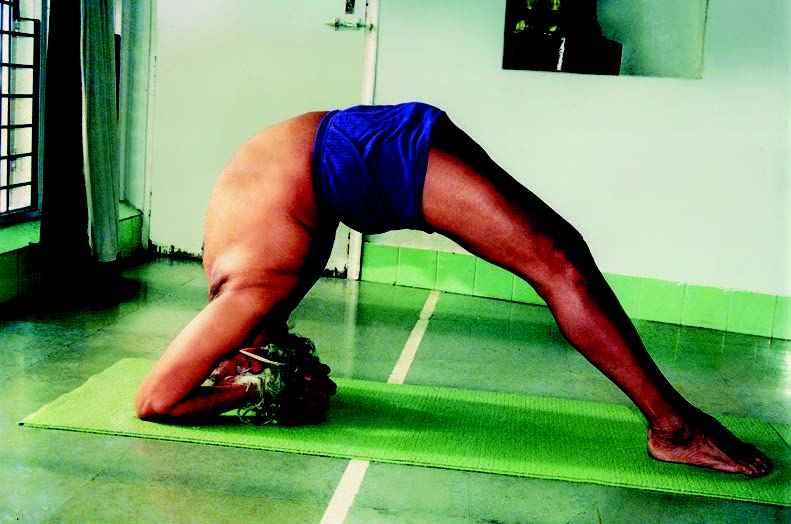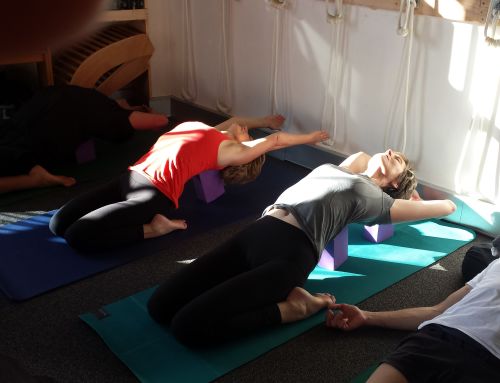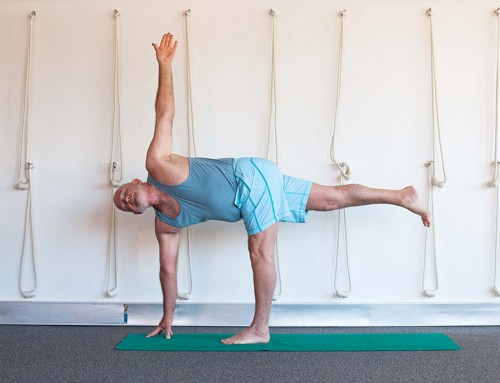Why Iyengar Yoga? by Carole Hart certified Iyengar teacher
First published in Well Being magazine, March 2004
Why yoga? If you ask people what they really want from life, most won’t say “a new car”, “a bigger house” or “a better job”. What most people want is very simple: they want to be happy and healthy.
But contemporary western life seems to conspire directly against happiness and good health. People work long hours, they get stressed juggling family and career, eat poorly and spend too much time sitting in front of computer screens. The result is a growing list of preventable maladies, including heart disease, depression, type 2 diabetes and obesity. Western drug-based medicine may help patch us up once the symptoms have appeared, but it doesn’t seem much help in preventing our problems in the first place.
Over the past 40 years increasing numbers of westerners have recognised that one of the most successful steps towards being happy and healthy is to follow a very ancient, non-western path, the path of yoga. Many people who turn to yoga for a better way of life take up Iyengar yoga. Who is BKS Iyengar, and what is his contribution? What is Iyengar yoga, what can be expected in an Iyengar yoga class? and how are Iyengar yoga teachers trained? accredited.
Why Iyengar yoga?
For many people around the world, the name BKS Iyengar is synonymous with the word yoga. Recognized as the world’s foremost exponent of yoga, Yogacharya (master teacher) BKS Iyengar, who recently turned 85, has been practicing yoga for 70 years. When he began learning yoga from his brother-in-law Shri T. Krishnamachar at the age of 15, he was a sickly youth. No natural athlete, Iyengar recalls that his young body was “as stiff as a poker! My middle finger could not reach my knees!”
BKS Iyengar became known in the west through his classic text Light on Yoga, first published in 1966 and never out of print since then. Gradually, during the years following the book’s publication, the term ‘Iyengar Yoga’ came into use. Mr. Iyengar has said “My pupils who follow me call it Iyengar yoga to distinguish it from others. Though I am rational I am tradition bound and sentimental. What I do is pure authentic traditional yoga, ashtanga yoga, known as the eight limbs of yoga, expounded by Patanjali”. His book Light on the Yoga Sutras of Patanjali (1993) is widely acknowledged as a book of great clarity, scholarly interpretation and commentary.
The yoga system of Patanjali, described in great detail over 2000 years ago, explains in 196 sutras (short phrases or aphorisms) how to achieve “the stilling of the turnings of thought”- which is how Patanjali defined yoga. He explained that to achieve the stillness of the mind we need to follow eight distinct ‘limbs’ ( ashtanga ), aspects or stages. The first two limbs concern our general behaviour: yama (universal moral commandments) and niyama (self purification by discipline); the next three limbs help us to steady our body: asana (yoga postures,), pranayama (rhythmic control of the breath), pratyahara (withdrawal from the domination of our senses), and the final three limbs of Patanjali’s yoga take us into the innermost recesses of the soul: dharana (concentration), dhyana (meditation), samadhi (profound meditation).
BKS Iyengar’s innovations in the understanding, practice and teaching of yoga are many. He demystified what was largely a secret, exclusive and inaccessible art. He brought yoga to the years ordinary man. BKS Iyengar – 2003 At the age of 85 he has not in any sense ‘retired’. Each morning for two to three hours he does his extraordinary personal practice, in the hall of the Ramamani Iyengar Memorial Institute (RIMYI) “along side his pupils” while most afternoons he can be found in the library, attending to correspondence, researching and writing. A philanthropist for many recently he has established a trust to build facilities, in his home village of Bellur , for young people to learn trades. Having taken yoga to the west his dream now is to bring yoga to the villages of India .
Yoga traditionally lays great emphasis on practice – sadhana . In the many years of developing his system of yoga, BKS Iyengar’s genius lies in his ability to use his own body to study the effects of various poses and breathing practices ( pranayama ). To this day he practices each asana, for many hours, pinpointing its purpose and discovering how it works then applying his knowledge systematically in both general and therapeutic instruction. BKS Iyengar is a teacher who never ceases to be a student himself.
Renowned throughout the world for his knowledge and therapeutic approach to yoga, using supports or “props” – ropes, pillows, bolsters wooden blocks, sticks, benches, mats and blankets, Mr Iyengar has worked with western doctors with great success in the fields of heart and immune disease and spinal and orthopaedic problems. This innovative approach to teaching and yoga therapy came from using stones, household bricks, tables and other ordinary objects in his early teaching days. Gradually he adapted and modified classical postures so that the patients’ ailing and stiff bodies could be supported in asanas without strain or the risk of further damage. Sporting teams from cricket, hockey, rugby league, rowing and tennis have come to Iyengar yoga to assist the players in sharpening their concentration, increasing their mobility and in recovering from injury.
Guruji, BKS Iyengar, in popularising yoga and modifying yoga for all, has not sacrificed the purity of its original teachings.
What to expect in an Iyengar yoga class
Those new to yoga will certainly know when they’ve walked into an Iyengar school! They will see not just the large, open space of the yoga room, but also an array of props. These props are the trademark of an Iyengar practice.
The props are used, not only by beginners, the very inflexible and those with disabilities, but by experienced, mature practitioners to assist in the understanding of the asana and to help them feel the correct movement and action without stress or strain. They are not, as the name may imply, a prop to be used all the time, but are used to give practitioners confidence, courage, clarity and a deeper understanding of asana in their practice, to help prepare the student for their practice of pranayama .
In a beginner’s class
As a beginner student attending an Iyengar class you will be encouraged to move along at your own pace (even though you are working in a group). You will be urged not to compete and to advise the teacher of any problems encountered.
At beginners’ level, students are introduced to simple asanas including some standing postures (such as the ‘triangle’ pose – or Utthita Trikonasana ) which help develop strength, stability, stamina, concentration and alignment. These standing poses are vital to the development of the more advanced poses, in particular the inverted poses such as the headstand ( Salamba Sirsasana ), which is not introduced until the student has become proficient in shoulder stand ( Salamba Sarvangasana ). The beginner is introduced to them gradually, with props and careful supervision by the teacher.
Teaching is oriented towards gradual but steady progress, rather than quick and fleeting results. Emphasis is given to different groups of asanas throughout the month, one week at a time. For example, in Week One standing poses are emphased, Week Two, forward bends, then backbends and in the fourth week the focus is on passive chest openings and restorative poses leading the practitioner, when becoming more experienced, to pranayama (breathing). This sequential learning of asanas gives the student a solid all-round base on which to build their practice. Each class will have a freshness as the teacher will sequence, time and link the asanas in different ways.
Progress varies depending on the individual – his/her starting point, attitude, desire to practice. It can be challenging. Slower for some, faster for others. As with learning any new skill, students may experience a plateau from time to time. Guruji sees sadhana (practice) as a qualitative evolutionary process. Yoga is both an evolutive (onward journey) and involutive (inward journey) path in the quest for the Soul. After even just one class you will notice a difference in your mental and physical health. Beginners find their concentration improves, their emotions steady, and they increasingly experience feelings of confidence and well-being. Many students find the benefits of yoga so great that they supplement their yoga classes with their own regular practice at home.
Beyond exercise: the special emphases of Iyengar yoga
Alignment (correct positioning of the body), timings (holding postures for varying amounts of time), sequencing (correct ordering) and linking (connecting one asana to another) of the asanas are unique to the practice of Iyengar yoga.
The method of Iyengar Yoga is not just about the correct alignment and precision of the asana. With correct alignment, timing, sequencing, and linking of yoga postures, yoga practice becomes a beneficial practice and ceases to be just a series of movements – a physical workout – or just exercise. How long you hold particular asanas and how asanas are sequenced can change the effects on the mind and the body. The same asanas held for different amounts of time and in a different order produce different effects on the chemistry of the body, on the muscles and bones, and on the emotions.
Linking of the asanas , linking the movement, the action, the inner adjustment of the basic postures to the next, and then the next and the next asana brings growth and a gradual discovery by the student of awareness and self-knowledge. BKS Iyengar’s system of teaching helps people to progress gradually from beginner to a long term proficient practitioner, while taking into account their strengths and their weaknesses.
Learning to breathe
Attention to the breath is an important aspect of Iyengar yoga. When doing the asanas (which are designed to build a strong, healthy body in the beginning) the practitioner is encouraged to breathe normally, and not to focus on the breath. Some practitioners may simply have to learn not to hold their breath while they’re doing the asanas ! But the emphasis at first is on attaining some stability in the asanas .
As the students become more experienced, they notice that the breathing changes depending on exactly how they are executing each asana . In more advanced classes, once students have physical stability and concentration, specific yogic breathing practices (pranayama) are introduced.
As BKS Iyengar says: Iyengar yoga is not just doing as you like. You have to find out. Am I synchronizing the energy of the body with the energy of my intelligence, or the energy of intelligence with the energy of my body? Is there synchronization? Is there harmony between the two? Whether it’s in the arch, the foot, the toe, arm, wrist, finger, whatever.
Meditation in action
BKS Iyengar suggests that through the practice of asana the practitioner can explore indirectly dhyana or meditation through dynamic/active meditation. Most people understand passive meditation. Sitting quietly in an asana with closed eyes, quietening the brain so that mental fluctuations and functions are brought to a state of stillness is passive meditation.
Dynamic/active meditation occurs when a practitioners involves themselves fully and intelligently in an asana , with the mind alert and moving with every action of the body, not allowing the mind to fluctuate -concentrating – and holding the attention with intensity and integrity of involvement,. BKS Iyengar says of this meditation-inaction: I introduce body concentration, while teaching asana and pranayama… I ask to look at the body and mind totally in an asana . I ask to see from within as well as from without. While doing the asana you learn to see one point and at the same time all points. This helps them to develop the art of concentration to go naturally towards meditation. Meditation is the art in which the consciousness is focused both centripetally and centrifugally. Here the attention is made to ascend not only vertically, but also made to spread horizontally on all parts of the body maintaining one-pointedness throughout.
Most of us cannot spend our lives sitting silently and alone in quiet, dark rooms. We must earn our livings. We must interact with our families. We must undertake the many busy tasks of daily life. Through active meditation in yoga practice, we learn how to take one-pointedness and stillness with us into even the most difficult or hectic of situations.
Your Iyengar yoga teacher
Teachers of Iyengar yoga in Australia (as in other countries) are trained, assessed and certificated under international guidelines given by BKS Iyengar. Training to be an Iyengar teacher to the first level of certification can take from three to five years of study and learning. Assessment of teachers at the first two levels is conducted by the BKS Iyengar Yoga Association of Australia, established in 1985, under strict criteria set down by BKS Iyengar himself. The more senior levels are still awarded directly by BKS Iyengar.
Iyengar teachers must renew their teaching certificates every three to five years, depending on their certification level, by receiving ongoing education. They must either attend classes at the Ramamani Iyengar Memorial Yoga Institute in Pune , India , or study with senior teachers here in Australia . All certified Iyengar teachers must have extensive knowledge of anatomy and physiology, and must have a current CPR certificate and insurance.
At present there are 170 teachers of varying levels of certification in Australia . You can recognize qualified Iyengar yoga teachers as they are licenced to display the Iyengar Yoga Certification Mark (it appears at the end of this article). BKS Iyengar has given permission only to those certified by the Association or any other Association world wide to use his name. No one without a teaching certificate in Iyengar yoga is entitled to claim to teach Iyengar yoga. The Certification Mark is your guarantee that your teacher is highly trained and fully qualified. To find a certified Iyengar yoga teacher near you, visit our Find a Teacher link.
Towards a new life
At its simplest, the regular practice of Iyengar yoga will improve your physical and mental health, make you feel peaceful and well, and radically improve your ability to cope with the ups and downs of everyday life. At its deepest, Iyengar yoga is a path which allows you to explore the vast unknown universe within yourself. Guruji, Yogacharya BKS Iyengar through his wisdom, tolerance, energy, research and teachings has given us a system of practice – Iyengar yoga – and, like all forms of yoga encourages us to search for that ‘spark of divinity’ .
As BKS Iyengar says: Yoga is a light, which once lit can never fade out. The more you do it the brighter the flame burns within you. Why should you practice Yoga? To kindle the divine fire within yourself. Everyone has a dormant spark of divinity in him which has to be fanned into flame





Leave A Comment